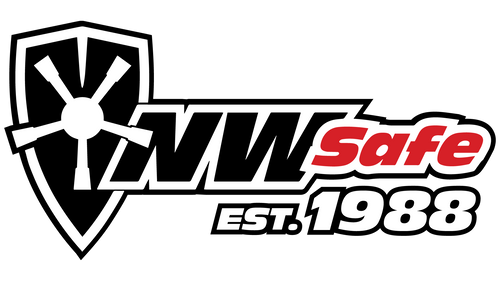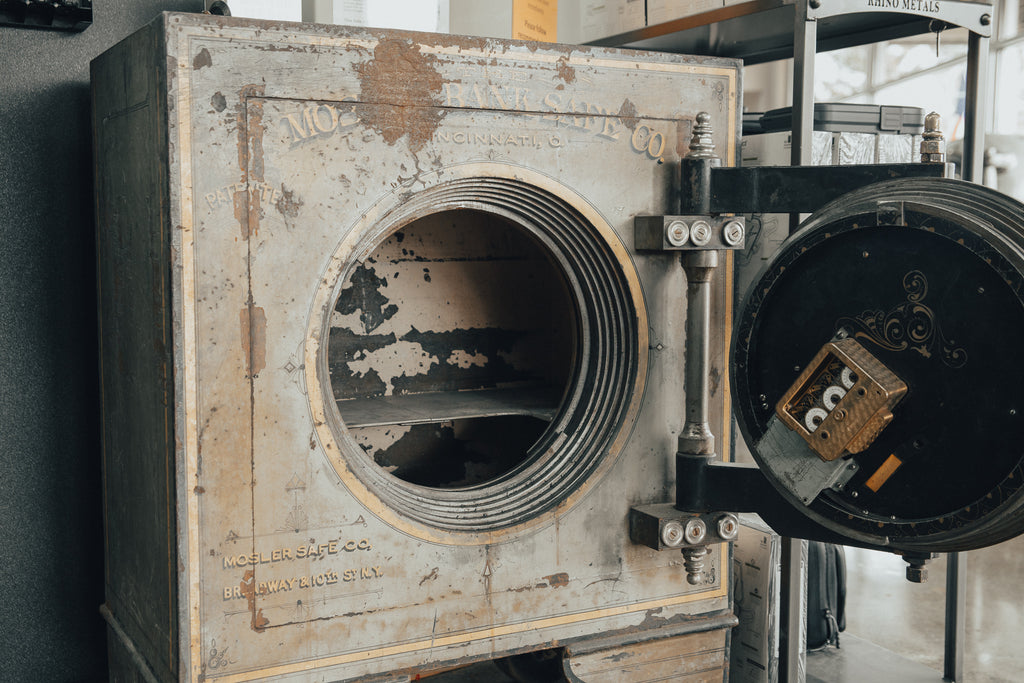Gun safes are as American as Thanksgiving turkey and football. They arose in popularity as pioneers conquered the wild west with colt steel on their hip and a need to stash their gold. But the origins of this USA icon can be traced to more distant shores. As it’s said, America’s the best kind of melting pot.
Safes Were First Manufactured in the 1700s

An iron safe with bronze decorations, including appliques heads of deities arranged in a row. It was found in Pompeii and now in the National Archaeological Museum of Naples. Photo By Giorgio Sommer - Brooklyn Museum, Public Domain
Some may claim the history of the gun safe industry traces all the way back to the Egyptian pyramids which housed, among other things, important scrolls. Julius Caesar is said to have filed his records in strong, iron boxes — perhaps similar to the one pictured above.
But the practice of protecting one’s valuables was never a new concept. Since men have been taking wives and hunting animals, they’ve looked for ways to keep others from stealing what’s theirs.
In reality, the beginning of what we recognize today as a gun safe was first manufactured in the 1700s. This is thanks to the precision metalworking that “allowed for a variety of new types of locks to be invented,” explained Stephen and Brenda Cohen in their co-authored book, America’s Scientific Treasures. The precision metalworking meant these safes had easily operated locks and swinging doors, compared to their somewhat cobbled together predecessors.
1818 Detector Lock Set the Bar for Safes
February 3, 1818, Charles Chub patented the ‘Detector Lock’ (patent no. 4219). The lock was regarded as the best of its kind, praised for its ability to stop petty pilfering and secure prison hulks. On the coattails of his early success, Charles moved to Wolverhampton, the center of English lock-making, with his brother Jeremiah Chubb.
The failure of their initial business expansion caused Jeremiah to depart for France and then America. Charles, who remained behind, would eventually convince the Admiralty fleet of Detector Lock’s superiority. The resulting business allowed him to expand his operations — a move that ultimately lead to long-term success.
Commercial ‘Fire-Proof’ Safe Manufactured in New York in 1826
The first safes weren’t actually called safes. They were known as ‘iron chests.’ Their intent was simple — prevent theft. Unfortunately, they did little to protect against heat. But in 1826, Jesse Delano patented what some believe to be the first commercial ‘fire-proof’ safe.
Jesse’s design coated a wooden enclosure with a mixture of “clay and lime, plumbago and mica, or saturated the wood with a solution of potash lye and alum.” The intent was to render it incombustible.
Over the years more patents were purchased for ‘fire-proof’ safe designs. None of these, including Jesse’s early design, are actually fire-proof — as a fire-proof safe does not exist.
Manganese Safe on Display in our Enumclaw Showroom



‘Burglar Proof’ Safe Manufactured at Large Scale in England
Charle Chubb’s’ initial expansion included supplying wrought iron doors, and safes and boxes with locks, to order. But, it was Charles’ 1835 patent for a burglar-resistant safe that would eventually make him a household name. By the mid-1840s he even appeared in playbills and popular verses of the time.
Upon passing away in 1845, Charles was succeeded by his son John. Patenting several improvements to his father’s products, John expanded the business.
Modern Roots of Fire-Resistant Gun Safes
Though Delano’s intent was in the right place, a true fire-resistant safe didn’t become available until 1840. Using the non-conducting power of plaster of Paris, Enos Wilder created a primitive fire-resistant safe he called the Salamander.
The makers of other safes ridiculed this invention, and Wilder challenged them to a public test, which was made at the Coffee-house-slip, foot of Wall-street, in 1840. The safes were all destroyed in the test but the Salamander, and that preserved the books and papers that had been put in it. (New York Times, June 25, 1881)
The Salamander patent was soon purchased by Wilder’s friend, Silas C. Herring. Herring established two manufactory and salesrooms in the United States, but sales were so slow only one locksmith was employed. As Herring made improvements upon the Salamander design, his operations grew. Today he’s recognized as one of the most well-known safe manufacturers of his time.
Herring’s Standards Live on with High-Quality Manufacturers
It goes without saying that not all safes are constructed equally. There are naysayers who will point to the Salamander fire demonstrations and claim the American gun safe manufacturing industry has gone downhill. It hasn’t.
Are there are gun safes for sale that have lower fire ratings than the monstrosities produced in the 1840s? Yes. However, this comparison of fire safes from the 1840s to today is not apples to apples. There are some key differences to take into account.
1. How the Safes Were Fire Tested
Average temperatures of a household fire have gone up, substantially. The test conducted in the 1840s simply did not burn as hot as the household fires we experience today. Nor did they reach their highest temperatures as quickly.
2. What Size Home Safes Consumers Need
Not all consumers want (or can store) a safe as big as the Salamander. It’s not uncommon that ladies and gents need a safe that will fit in their closet or condo. While this is not always the case, many of the smaller framed safes have smaller fire ratings.
3. How an Individual Plans to Use Their Safe
It’s not uncommon that fire isn’t a major concern for gun safe owners. In fact, we often have customers who need a quick access safe that make gun storage as convenient as possible.
Fire Resistant Liberty Safes
Fire ratings in the gun safe industry are not regulated. Manufacturers can legally place any fire rating they want on their safe. Liberty is a unique gun safe manufacturer, in that they do extensive testing.
They replicate both the conditions of a modern house fire, in both temperatures and speed to the highest temp. Furthermore, Liberty is transparent about their findings — sharing video evidence of their testing process and results.
These gun safes aren’t just security cabinets where you’re locking up middle school test scores. From firearms storage to precious metals, Liberty gun safe fire ratings deliver reliable peace of mind.
See History First-Hand in Our Enumclaw Showroom
We have more than a dozen historic safes throughout our Enumclaw showroom. The condition of these safes varies, as some were maintained better than others. These are a few of the old safes you can see first hand:
Old Tacoma City Hall Safe
The old Tacoma City Hall opened in 1893. It is believed the safe was built that same year. The building, which still stands at the intersection of Pacific Ave. and South 7th St. in Tacoma served as City Hall through the early 20th Century.
The safe was used to house important documents, valuables, and cash. It was manufactured by the Molser Safe Company. The exterior shows numerous hammer blows. We believe these were administered to free stuck levels in the time lock, allowing the safe to be opened.
Upon close inspection, a small ¼-inch hole can be seen in the top of the safe near the center (roughly 4-inches from the front). While the hole has now been plugged, it was drilled by a safe technician and used to open the safe when the hammer blows failed to work.

1913 Molser Safe
In 1867, Gustave Molser and Fred Bahmann founded the Mosler, Bahmann & Company in 1867. But following Gustave’s death in 1874, the Mosler family and Bahmann had a falling out. Splitting from Bahmann, the Mosler family formed the Mosler Safe & Lock Company.
Both companies remained in Cincinnati until the 1980s, when Mosler Safe & Lock Company outgrew its original factory and relocated to Hamilton in 1981. Over the years, Mosler became known for building some of the strongest safes in existence, thanks to their strength and precision manufacturing.
Prior to closing due to bankruptcy in 2001, Mosler built thousands of safes, vault doors, and vault rooms. Among the notable vaults were several that were installed in Hiroshima’s Mitsui bank building which survived the WWII nuclear attack. Mosler played a critical role in the 1936 construction of the United States Bullion Depository (aka Fort Knox).
The 1913 Mosler Safe on display in our Pacific Northwest gun safe showroom was custom built for the Butte, Montana Legget Hotel. The hotel was said to be one of the finest and most opulent in all of Montana. Standing at six stories, it had 91 rooms and a posh dining room. The small inner compartments were purposely built to hold the valuables of elite guests a hotel of this stature attracted.
Visit our Enumclaw showroom to view our collection of historic safes and modern day gun safes for sale.

